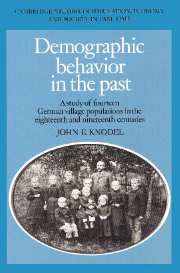 Demographic Behavior in the Past
Demographic Behavior in the Past Published online by Cambridge University Press: 04 August 2010
The relationship between mortality and fertility has been a matter of interest since the early days of population research. Concern with the nature and extent of the relationship has heightened since the formulation of demographic transition theory, which attributes central importance to the timing and interdependence of the secular declines in birth and death rates in Western demographic experience. Fertility can influence mortality in a variety of ways and in Chapter 4 the impact of the birth interval on infant mortality was examined. Most interest, however, has focused on the effect of mortality, and particularly infant and child mortality, on reproductive behavior. Recent conceptualization of this relationship has identified several different potential effects. These include an insurance (or hoarding) effect whereby couples have extra children in anticipation of child mortality, a replacement effect whereby couples have replacement births in response to their own actual (as opposed to anticipated) experience with child loss, and an involuntary physiological effect on the interval between births attributable to the interruption of breastfeeding and the consequent shortening of the postpartum non-susceptible period. At a different level, a societal effect is sometimes identified which operates indirectly (and presumably unconsciously) through social customs to adjust the community fertility level to the community mortality level.
To save this book to your Kindle, first ensure no-reply@cambridge.org is added to your Approved Personal Document E-mail List under your Personal Document Settings on the Manage Your Content and Devices page of your Amazon account. Then enter the ‘name’ part of your Kindle email address below. Find out more about saving to your Kindle.
Note you can select to save to either the @free.kindle.com or @kindle.com variations. ‘@free.kindle.com’ emails are free but can only be saved to your device when it is connected to wi-fi. ‘@kindle.com’ emails can be delivered even when you are not connected to wi-fi, but note that service fees apply.
Find out more about the Kindle Personal Document Service.
To save content items to your account, please confirm that you agree to abide by our usage policies. If this is the first time you use this feature, you will be asked to authorise Cambridge Core to connect with your account. Find out more about saving content to Dropbox.
To save content items to your account, please confirm that you agree to abide by our usage policies. If this is the first time you use this feature, you will be asked to authorise Cambridge Core to connect with your account. Find out more about saving content to Google Drive.